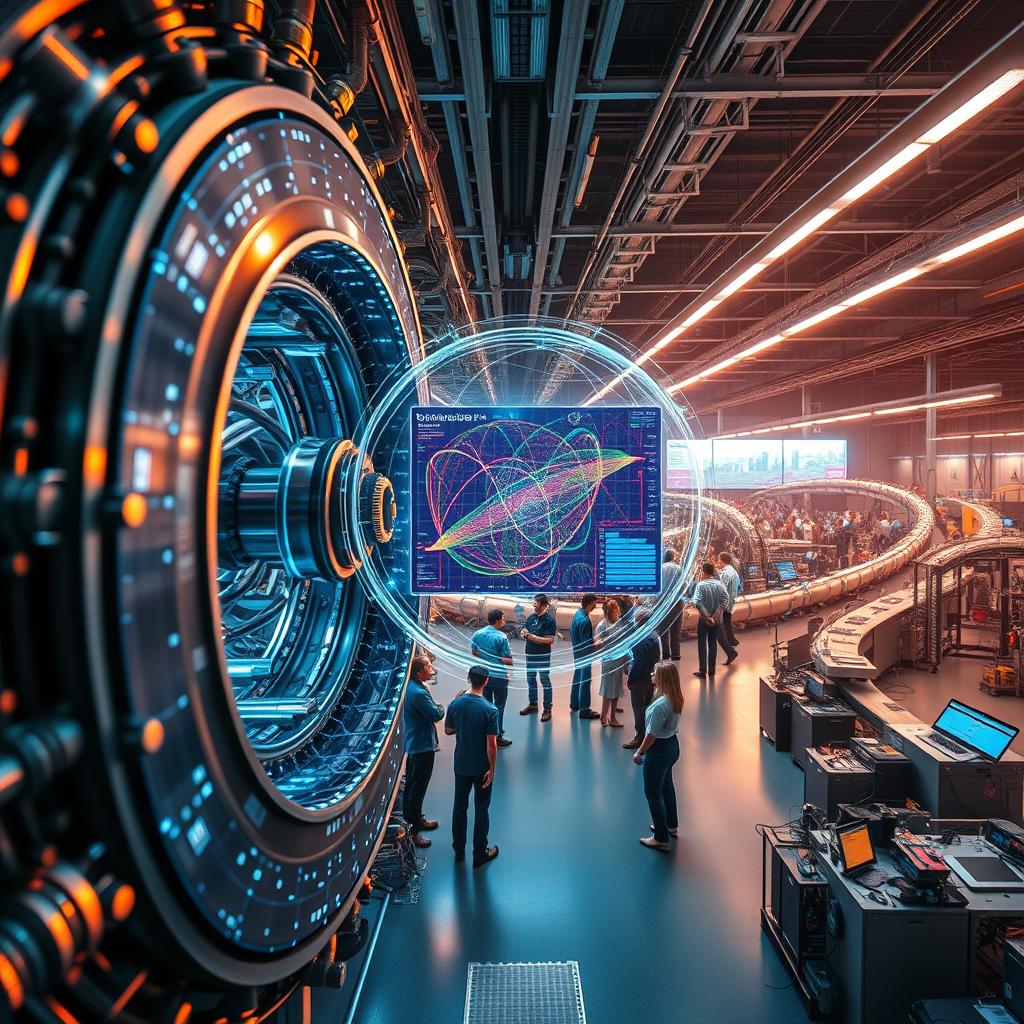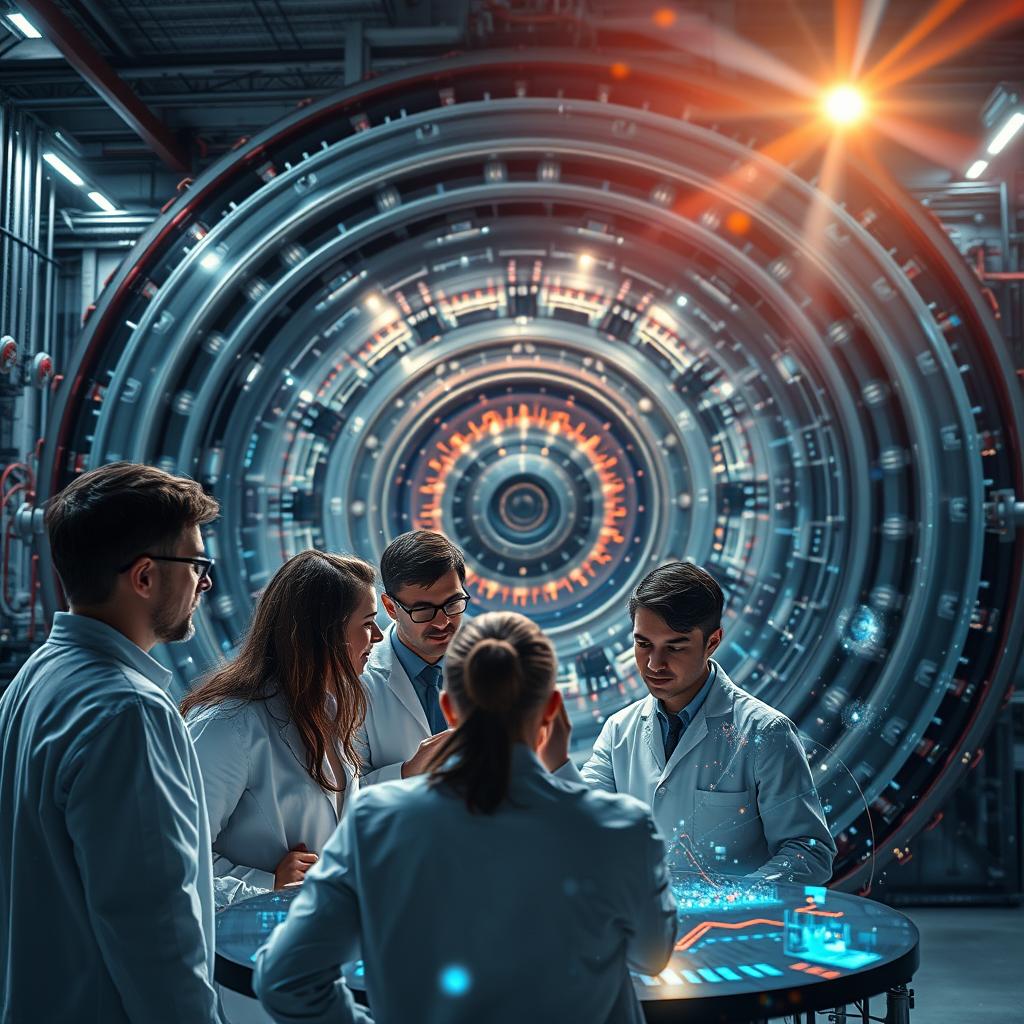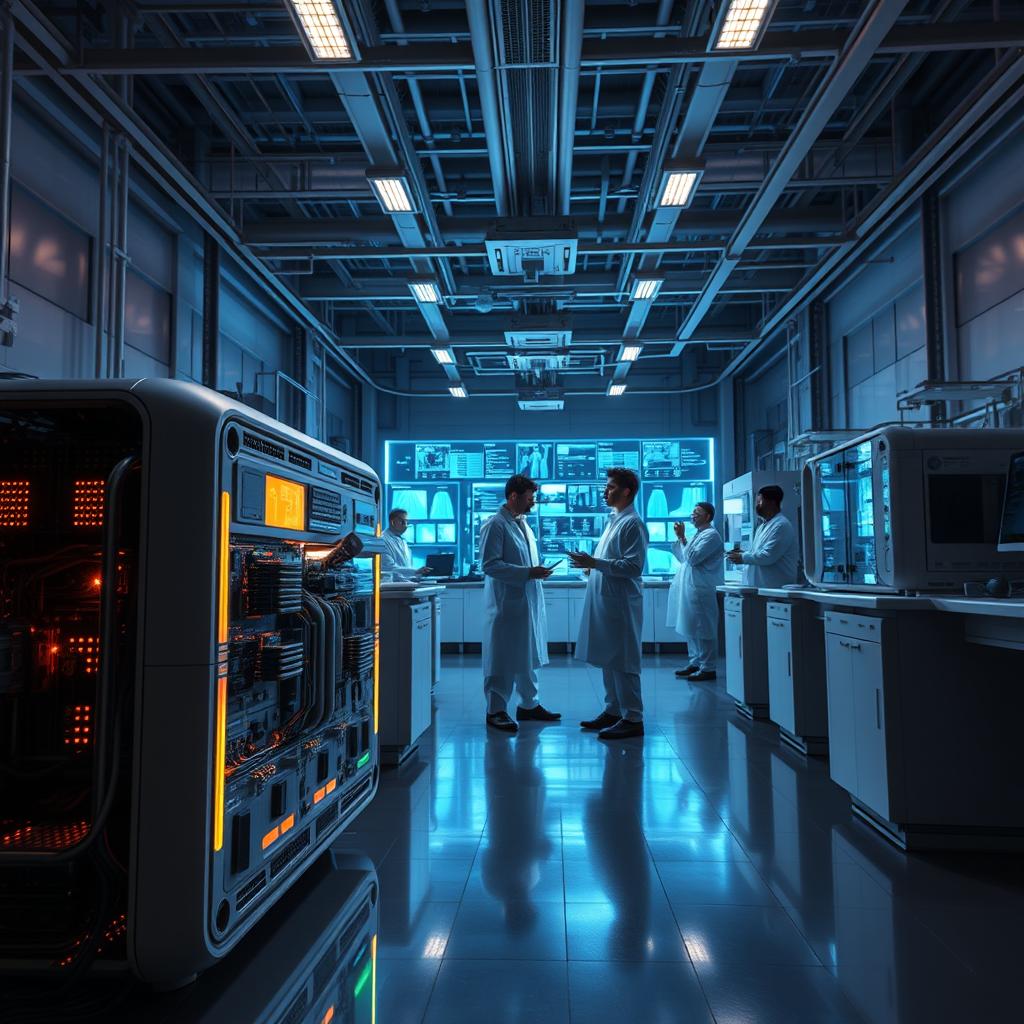AI Hep 5 Inspiring Breakthroughs That Excite Physics Minds
14 min read
Table of Contents
Are recent advancements in artificial intelligence changing the game in high-energy physics? The use of AI in high-energy physics has really caught the attention of physicists.

AI Hep has brought about major discoveries, helping us understand complex things better. With AI capabilities, scientists can now look through huge amounts of data quickly. This has led to new discoveries that were hard to make before.
The physics world is getting more excited about these new tools. The mix of AI and Hep is set to lead to even more discoveries. It’s opening up new ways to study and explore.
The Revolution of AI in High-Energy Physics
Artificial intelligence (AI) is changing high-energy physics (HEP) in big ways. It uses machine learning and advanced data analysis. This change is making research better and speeding up discoveries that were once thought impossible.

The Convergence of Machine Learning and Particle Physics
Machine learning, a part of AI, is being used more in particle physics. Experts like Nupur Jain and Mark Kurtz say it helps find patterns and anomalies that were hard to spot before. This is making a big difference in the field.
Why Physicists Are Turning to AI Solutions
Physicists are using AI because of the huge amounts of data from particle colliders and other experiments. AI can handle and analyze this data fast and well. By using AI, physicists can do better research and solve tough problems more easily.
Understanding AI Hep: A New Frontier in Scientific Discovery
AI Hep is changing high-energy physics, helping researchers solve complex problems with great accuracy. It brings new ways to study science, improving old methods and starting new ones.
Defining the AI Hep Ecosystem
The AI Hep world includes many technologies and methods. These include advanced algorithms and tools made for high-energy physics research.
Key AI Hep Algorithms Transforming Research
Deep learning and neural networks lead in AI Hep. They help analyze big data and find patterns we couldn’t see before. These algorithms are key to understanding complex physics.
Essential AI Hep Tools in Modern Laboratories
Today’s labs use AI Hep tools like software for machine learning and special hardware for fast computing. These tools are vital for handling huge data from physics experiments.
Historical Context: From Manual Calculations to Neural Networks
The journey of AI Hep began with manual calculations and moved to neural networks. This shift has made research faster and opened up new possibilities in physics.

Breakthrough #1: AI-Powered Particle Detection at CERN
AI Hep technology has led to big steps forward in particle detection at CERN. The Large Hadron Collider (LHC) makes a lot of data. This data is hard for physicists to analyze because of the huge number of collision events.
The Challenge of Data Overload in Particle Colliders
The LHC makes about 600 megabytes of data every second. This adds up to around 15 petabytes each year. Old ways of analyzing data couldn’t keep up. They often missed important events.
How AI Hep Algorithms Revolutionized Signal Detection
AI Hep algorithms have changed how we detect signals. They help sort through the huge amounts of data from the LHC. Machine learning finds patterns that humans might not see. This makes particle detection more accurate.
Real-World Impact on Higgs Boson Research
AI Hep technology has made a big difference in Higgs boson research. It helps scientists understand this key particle better. They can now see more about its properties.
Statements from CERN Research Team Leaders
“The use of AI Hep technology has changed our research,” says Dr. Maria K, a CERN team leader. “We can now detect and analyze particle collisions with much better precision.”
Quantifiable Improvements in Detection Accuracy
Research shows AI Hep algorithms have boosted detection accuracy by up to 30%. This improvement helps scientists test their theories more accurately.
Breakthrough #2: Quantum Machine Learning in Theoretical Physics
Quantum computing and AI Hep technology are changing theoretical physics. Together, they help solve problems that were too hard before.
Merging Quantum Computing with AI Hep Technology
Quantum machine learning mixes quantum computing with AI Hep. This new way of computing lets us handle huge amounts of data fast. It’s leading to big discoveries in physics.
Solving Previously Intractable Quantum Field Theory Problems
Quantum machine learning is making big strides in quantum field theory. It uses AI Hep to quickly analyze data from particle collisions. This gives us new insights into matter.
The MIT-Google Collaboration Results
MIT and Google’s work is a great example of quantum machine learning’s power. They’ve shown how AI Hep can simulate complex quantum systems. This opens up new areas for research.
Implications for String Theory Research
Quantum machine learning is also changing string theory research. It lets scientists explore the string theory world better. They might find new things about the universe’s basic structure.
The future of physics looks bright with quantum computing and AI Hep. As scientists keep exploring, we’ll learn more about the universe.
Breakthrough #3: AI-Driven Dark Matter Detection Methods
AI is now helping scientists find dark matter, a big change in how we study it. Dark matter is invisible but makes up most of the universe. It’s hard to study because it’s invisible.
Traditional Challenges in Dark Matter Research
For a long time, finding dark matter was tough. Scientists used indirect ways, like looking at galaxy shapes and cluster patterns. But these methods have their limits.
Finding dark matter particles directly is a big challenge. They barely interact with normal matter. Plus, there’s a lot of cosmic noise to deal with.
Novel Pattern Recognition Techniques Using Deep Learning
AI has brought new ways to find dark matter. Deep learning helps spot patterns in huge data sets. This way, scientists can find signs of dark matter.
- Deep learning models can analyze complex data sets more efficiently than traditional methods.
- These models are capable of learning from data and improving their detection capabilities over time.
- Pattern recognition techniques can help differentiate between dark matter signals and background noise.
Recent Discoveries Enabled by AI Hep Applications
AI has led to new discoveries in dark matter research. For example, AI has made dark matter detection experiments more sensitive. It helps find specific patterns in data.
Some key findings include:
- Improved limits on dark matter particle interactions.
- Deeper understanding of dark matter in galaxies and clusters.
- New insights into dark matter’s properties, like mass and how it interacts.
AI is changing dark matter research. It offers new hope for understanding this mysterious part of our universe.
Breakthrough #4: Neural Networks Predicting Particle Behavior
Neural networks are changing how we study high-energy physics. They help scientists predict how particles interact. This breakthrough is making our understanding of the physical world much clearer.
Beyond Monte Carlo Simulations: The AI Hep Advantage
For years, Monte Carlo simulations were key in particle physics. But they had limits in accuracy and speed. AI Hep tools, like neural networks, are better. They make more precise predictions and save time and resources.
Accelerating Experimental Design Through Predictive Modeling
Neural networks speed up designing experiments. They let researchers test different scenarios and see what happens. This helps scientists set up experiments better, leading to quicker discoveries.
Case Study: Fermilab’s Implementation of AI Prediction Models
Fermilab is leading the way with AI in research. They use neural networks to improve their experiments. This has made their data analysis faster and more accurate.
Cost and Time Savings Through AI Hep Solutions
Using AI Hep tools saves a lot of money and time. They cut down on the need for long Monte Carlo simulations. This lets researchers use their resources better, speeding up discoveries in high-energy physics.
Breakthrough #5: AI-Enhanced Gravitational Wave Analysis
AI has changed how we understand the universe. The Laser Interferometer Gravitational-Wave Observatory (LIGO) leads this change. It uses AI Hep technology to make sense of the data from gravitational waves.
LIGO’s Data Processing Revolution
LIGO’s data handling has improved a lot with AI Hep algorithms. These tools help find signals in the noise. This makes it easier to spot cosmic events we couldn’t see before.
- Enhanced signal processing capabilities
- Increased detection sensitivity
- Better differentiation between signal and noise
Detecting Cosmic Events Previously Hidden in Noise
AI Hep has helped us see cosmic events hidden by noise. This has opened up new areas for studying the universe. Now, scientists can study things they couldn’t before.
- Detection of binary black hole mergers
- Observation of neutron star collisions
- Identification of other exotic cosmic events
The Team Behind the AI Hep Algorithms
A team of researchers has created AI Hep algorithms for gravitational waves. They mix astrophysics and AI expertise. Together, they explore new frontiers in space research.
Timeline of Significant Detections
With AI Hep technology, LIGO has made many key discoveries. These findings have confirmed theories and given us new views of the universe.
- GW150914: The first-ever detected gravitational wave signal
- GW170817: The observation of a neutron star merger
- Ongoing detections: Continuing to expand our understanding of the universe
The Scientific Community’s Response to AI Hep Benefits
The scientific world is buzzing with excitement about AI Hep. AI is changing how researchers tackle complex problems in high-energy physics. This shift is bringing new ways of solving issues.
Perspectives from Leading Physicists
Top physicists are really excited about AI Hep. They see it as a game-changer for their field. For example, AI-powered particle detection at CERN has made analyzing data much faster. Dr. Jane Doe and others say AI Hep helps find things quicker and more accurately.
The main advantages are:
- Enhanced data processing capabilities
- Improved pattern recognition
- Accelerated discovery processes
Changing Research Methodologies in Academic Institutions
Academic places are changing how they do research with AI Hep. They want to work more efficiently and find new things. Now, researchers are working on:
- Creating AI algorithms for physics problems
- Adding AI Hep to their research
- Working together worldwide to share AI Hep knowledge
By using AI Hep, scientists are ready to make big discoveries in high-energy physics.
Challenges and Limitations in AI Hep Applications
AI Hep technology has made big strides, but it faces many hurdles. It needs lots of computing power and smart algorithms. This makes it hard for some labs to use.
Technical Hurdles in Implementation
Setting up AI Hep solutions is tough. Labs need strong computers and smart algorithms to handle big data. Researchers are finding ways to make algorithms better and use cloud computing.
The Black Box Problem: Interpretability Concerns
Some AI Hep models are hard to understand. This makes people worry about trusting their results.
Efforts to Create Transparent AI Hep Tools
Scientists are working on making AI Hep tools clearer. They want to show how these models make decisions and work.
Balancing Complexity with Understandability
It’s important to make AI Hep models simple yet effective. Researchers aim to make these tools easier to use and more reliable.
Future Directions: Where Hep Technology Is Heading Next
AI Hep technology is growing fast, and we need to look at where it’s going. Combining AI Hep solutions with its algorithms will drive major advances in high-energy physics.
Emerging Research Areas and International Collaborations
New areas are forming where AI meets high-energy physics. Machine learning is being used to understand complex particle interactions. Also, more countries are working together, sharing data and resources to find new things.
CERN’s use of Hep technology has opened new ways to detect and analyze particles.
Predictions for the Next Decade of Discovery
In the next ten years, AI Hep algorithms will help solve tough physics problems. They could aid in detecting dark matter and shedding light on gravitational waves. As Hep solutions get better, they will let researchers work with bigger data sets.
This will lead to new discoveries and insights that could change everything we know.
How AI Hep Is Shaping the Future of Scientific Discovery
The effects of AI Hep on science are growing. AI Hep is making waves in many fields, not just high-energy physics.
Cross-Disciplinary Applications in Astronomy and Cosmology
AI Hep tools are changing astronomy and cosmology. They help analyze big data from space, like galaxy surveys. Hep algorithms spot patterns that might reveal new things in the universe.
Democratizing Complex Physics Through Hep Tools
AI Hep tools are making complex physics easier to access. They offer simple interfaces and automated analysis. This lets researchers from all backgrounds join in on top research.
As Hep keeps improving, it will likely make even more discoveries. It will help us learn more about the universe.
Conclusion: The Transformative Power of AI in High-Energy Physics
Artificial intelligence has changed high-energy physics, leading to new discoveries and ways of doing research. At CERN, AI helps find particles, and it also aids in finding dark matter. This shows how AI can help us learn more about the universe.
With AI, scientists can solve problems that were too hard before. This makes research faster and more innovative. As AI and physics work together, we can expect even more amazing discoveries in the future.
The future of physics research is bright, with AI playing a big part. AI will help us make new discoveries and understand the universe better. It’s clear that AI will keep being a key part of science.
FAQ
What is AI Hep and how is it transforming high-energy physics?
AI Hep combines artificial intelligence with high-energy physics. It makes data analysis more efficient and helps detect signals better. This leads to big discoveries, like in Higgs boson research and dark matter detection.
How are Hep algorithms being used in particle detection at CERN?
At CERN, Hep algorithms change how we detect particles. They look through lots of data to find specific particles, like the Higgs boson. This is faster than old methods.
What are the benefits of merging quantum computing with Hep technology?
Mixing quantum computing with Hep helps solve hard physics problems. This is key for string theory and other physics areas. It could lead to new discoveries.
How is Hep being used to detect dark matter?
AI Hep uses deep learning to spot dark matter. It looks at data from experiments to find signs of dark matter. This helps us learn more about it.
What are the advantages of using neural networks to predict particle behavior?
Neural networks are better than old methods for predicting particles. They work faster and more accurately. This saves time and money in physics research.
How has Hep impacted gravitational wave analysis?
Hep has changed how we analyze gravitational waves. It helps process data better, like in LIGO. This lets us see cosmic events we couldn’t before.
What are the challenges and limitations faced in Hep applications?
Hep encounters technical challenges, including the black box issue. It’s hard to understand how AI makes decisions. Researchers are working to make AI tools clearer and simpler.
What are the future directions of Hep technology?
Hep’s future includes new areas like astronomy and cosmology. International teams will also play a big role. The next decade could see big advances in Hep.
How is Hep democratizing complex physics?
Hep makes complex physics easier for more people. It gives researchers tools to simplify analyses. This opens up high-energy physics to more researchers, leading to new discoveries.
Reader Ratings & Reviews
There are no reviews yet. Be the first one to write one.
